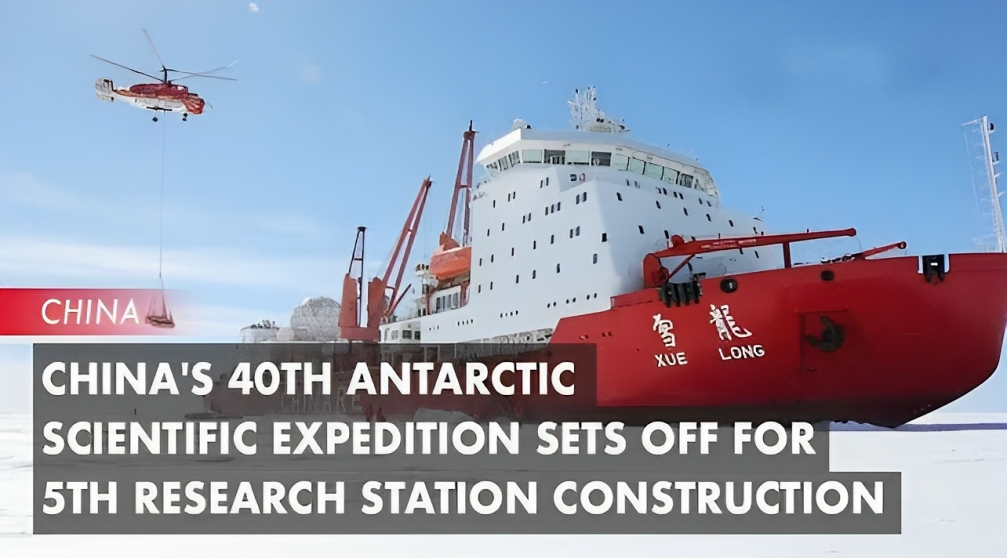The 40th Antarctic expedition team from China
China 40th Antarctic expedition

China’s research icebreaker Xuelong-2, part of the 40th Antarctic expedition, met up with the supply vessel Tianhui in the waters near the South Island of New Zealand. On Saturday, the two ships began navigating through the westerlies as they make their way to Antarctica.
The expedition crew embarked on their journey on November 1, embarking on a mission that spans over five months.
As they make their way, they’ll be encountering the westerlies, those consistent winds that typically occur between 40 and 60 degrees in the middle latitudes. These winds can be quite robust, scoring 6 to 7 on the Beaufort scale, and they create ocean swells ranging from four to five meters in height throughout the year.
Navigating through the westerlies poses one of the numerous challenges for Antarctic expeditions, prompting the crews aboard the expedition ships to take precautions. They secured equipment, including a helicopter, to the decks of their vessels in preparation.
The cargo vessel Tianhui is hauling construction materials, weighing approximately 9,300 tonnes, destined for China’s new Antarctic research station. This includes steel components, modules, curtain wall panels, and various sand and gravel materials, as shared by Zheng Di, deputy team leader of the Ross Sea scientific research station.
The offered price for Tata Technologies has been settled at ₹500 per share. Here are the details.
Ensuring the safe journey of the two ships through the westerlies required collaborative efforts from ship captains and expedition leaders, who meticulously charted the optimal route.
Xiao Zhimin, captain of Xuelong-2, shared, “Based on the meteorological forecasts we have collected, we conducted a comprehensive assessment, and overall it is manageable. Our current plan is to navigate below the area with swells reaching four meters whenever possible.”
China embarks on 40th Antarctic expedition, new research station to be expected
China’s 40th Antarctic scientific expedition team set sail from their home port in Shanghai, marking the beginning of their journey.
Comprising more than 460 staff from over 80 domestic institutions, the team is set to return in April 2024, concluding their expedition that spans five months.
What makes this expedition noteworthy is that it’s the first time China’s Antarctic scientific mission is supported by three vessels. These include the two polar icebreakers, Xuelong and Xuelong-2, alongside a cargo ship named Tianhui.
The icebreakers will play a pivotal role in scientific exploration, personnel transportation, and logistical support. Meanwhile, the cargo ship, which set sail from Zhangjiagang City in Jiangsu Province, will be responsible for transporting materials crucial for the construction of the new scientific research station—a significant undertaking for this expedition.
Mission highlights: Shenzhou-16 embarks on new chapter of China Space Station operation
The upcoming research station, nestled in the coastal region of the Ross Sea, is poised to become China’s fifth Antarctic research facility. Distinguished as the third year-round station after the Great Wall and Zhongshan stations, it holds the unique status of being the first one situated in the Pacific Ocean sector.
This station is not just bricks and mortar; it’s designed for diverse observations, monitoring, and scientific research across various realms, including the atmospheric environment, marine ecosystems, and biological ecology.
Once the construction dust settles, the station is envisioned to host 80 expedition members during the summer and 30 during the winter months.
Beyond its physical infrastructure, the expedition aims to delve into the intricate dynamics of climate change’s impact on Antarctic ecosystems. There’s a profound commitment to understanding Antarctica’s role in the larger narrative of global climate change.
Moreover, this endeavor is not a solo act. It embraces international collaboration, featuring joint research ventures in cutting-edge Antarctic science. There’s also a noteworthy aerial survey over Enderby Land, a collaborative effort involving Norway, Australia, and other nations.
The spirit of collaboration extends to logistics support, weaving a network that includes the United States, the United Kingdom, Australia, Italy, South Korea, Russia, Chile, and several other countries. This collective effort mirrors the shared responsibility in exploring and understanding the Antarctic frontier.
